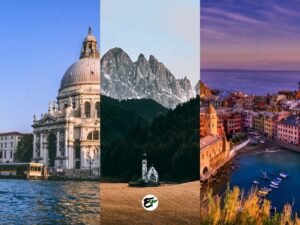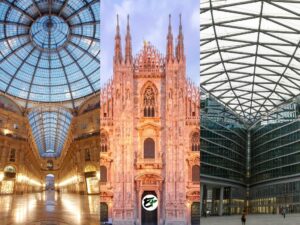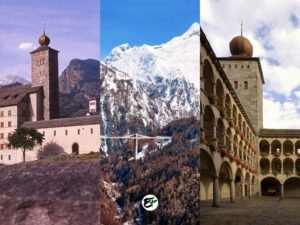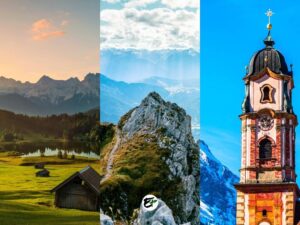Explore Nuremberg: 15 Highlights that Make It Worth a Visit
For over two decades of my life, I had no idea that Germany had cities that looked like they were straight out of a fairytale. It wasn’t until I discovered Nuremberg that I felt like I had stumbled upon Disneyland for adults.
As I wandered through Nuremberg’s quaint streets with their colorful half-timbered houses and visited its time-honored landmarks such as Schöner Brunnen, Imperial Castle, and Sebalduskirche, I couldn’t help but wonder why Nuremberg isn’t as well-known as other German cities like Berlin, Munich, and Cologne.
Amazed by Nuremberg’s charming streets, it’s hard not to say Nuremberg is a must-see destination in Germany, at least for every wanderer exploring the world. In this post, I’ll share all the reasons why.
If you’re a traveler who’s unsure whether to add Nuremberg to your itinerary, I hope to help you make up your mind by highlighting all the beautiful things I discovered in this charming city. So, let’s get started!
This post contains affiliate links. I may receive a tiny commission at no additional cost to you.
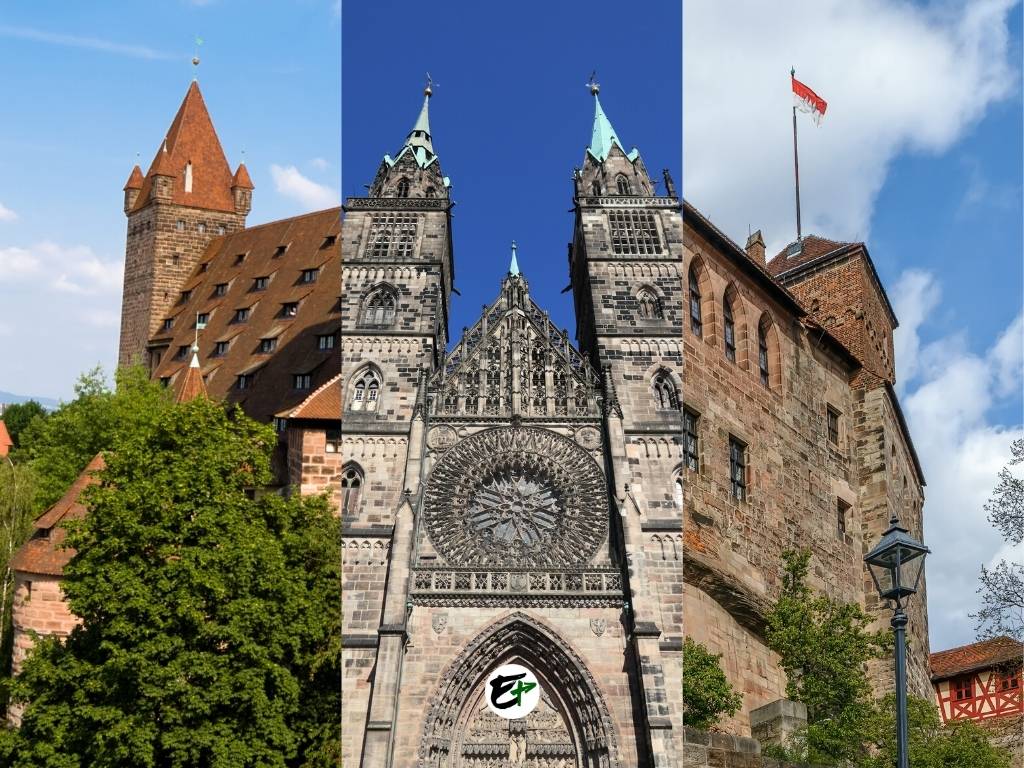
Use the table of contents to skip to topics.
Briefly, Nuremberg is the second-largest city in the German state of Bavaria, Southern Germany, and it’s a popular starting point for travelers looking to explore the charming small towns in the nearby Franconian Region. But, again, Nuremberg is worth exploring in its own right – it has a unique charm that sets it apart from other big cities in Germany.
Nuremberg offers unique experience like the Documentation Center Nazi Party Rally Grounds, which offers visitors a chance to learn more about this important period in German history. There’s more to discover in Nuremberg and I’m excited to tell them to you.
As you read my reasons to visit Nuremberg, you’ll also find the information below to help you explore the Nuremberg when you decide that you’ll be spending time here.
- Exact map locations of the landmarks and tourist attractions in Nuremberg. (with links to Google Maps).
- Visiting information for the tourist attractions in Nuremberg.
- Tips and recommendations for an enjoyable/full-of-discovery visit to Nuremberg.
If you’ll need an itinerary for Nuremberg, I also got you covered. All the practical information in visiting Nuremberg is included in it. You can find the best hotel deals in Nuremberg here.
1. Nuremberg’s Picturesque Streets
Those who hail from newer countries and find themselves drawn to the magic of Europe’s medieval city centers, Nuremberg is an unmissable stop on your itinerary! Founded almost a millennium ago, this historic city is steeped in medieval charm. Its cobblestone streets, brick buildings, and numerous other timeless sights make Nuremberg a living testament to history.
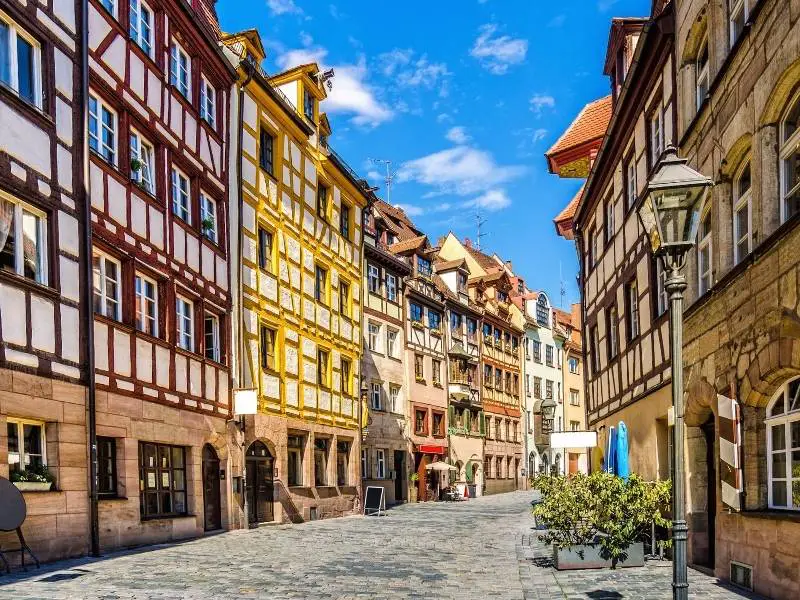
Before you set foot in Nuremberg, make sure to free up some space on your camera. The city is a treasure trove of stunning visuals that you’ll want to capture! Take a leisurely walk along the River Pegnitz, where charming bridges and timber-framed houses await.
Wondering where to find the most photogenic spots in Nuremberg? No need to worry! I’ve got the exact locations of Nuremberg’s picture-perfect places right here.
Among the many remarkable places in Nuremberg, Weissgerbergasse stands out. This street, with its charming pastel-colored, timber-framed houses, is undeniably picturesque. The sight of these houses, which form the largest collection of old artisan houses in the city according to tourism officials, is truly impressive.
Today, Weissgerbergasse is a lively area filled with inviting cafes, quaint shops, and welcoming bars – a perfect place to unwind after a day of city exploration. Here are some of the ways you can explore Nuremberg:
Europe is filled with beautiful cities like Nuremberg, we can all agree! Below are the cities similar to Nuremberg (they also have picturesque streets). I suggest you discover (click the names of the city to read the article—they open in a new tab):
- Strasbourg—it is the capital of Europe that has half-timber framed houses, a Haussman architecture new city, and a charming medieval old town center.
- Colmar—the most fairytale town in France filled with half-timber framed houses. It’s so beautiful it was copied in other countries, i.e., Malaysia.
- Bern—Its historic center is a stunning UNESCO site with cute fountains and picturesque streets.
- Verona—it is the Romantic city where the story of Romeo and Juliet is set. It also has a 2000-year-old arena like Rome.
- Bergamo—do you want to visit a medieval place with scenic views? Here’s where you should go.
- Florence—it is where the Renaissance was born. It has stunning landmarks, thousands of artworks, and lovely city views. You’ll like visiting it.
2. Beautiful Churches in Nuremberg
For those with an appreciation for magnificent architecture, Nuremberg is a destination worth considering. The city boasts a variety of stunning buildings that will quench your thirst for architectural beauty. The churches in particular showcase Nuremberg’s distinctive craftsmanship and exceptional artistry.
With nearly ten remarkable churches to explore, Nuremberg offers something for everyone. Three of these churches can be found in the city’s north, while the remainder are in the south, with the River Pegnitz acting as a central dividing line. While I personally find Sebalduskirche, Frauenkirche, and Lorenzkirche to be the most beautiful, it’s important to remember that beauty is subjective.
Sebalduskirche

The first church on our list, Sebalduskirche, also happens to be Nuremberg’s earliest parish church. It’s hard to believe that it was established way back in 1215 – that’s over eight centuries ago! One of Nuremberg’s tallest structures, it’s located north of the Pegnitz and faces the old city hall.
hile Sebalduskirche might not top the list of Europe’s most beautiful churches, its architectural merit is exceptional. Its detailed rose windows are particularly captivating.
Inside, you’ll find a high and narrow nave framed by stunning stained-glass windows. The play of sunlight through these windows lends an enchanting aura to the church. Despite some artwork being lost in WWII, there are still many remarkable pieces to be found within its walls, such as Peter Visher’s Monument of Saint Sebaldus.
360-degree-image of Sebalduskirche above (Swipe to see more views)
Visiting hours for Sebalduskirche start from 9:30 am to 4:00 pm from January to March and 6:00 pm from April to December. German tours are available every Wednesday and Saturday at 3:00 pm.
Lorenzkirche
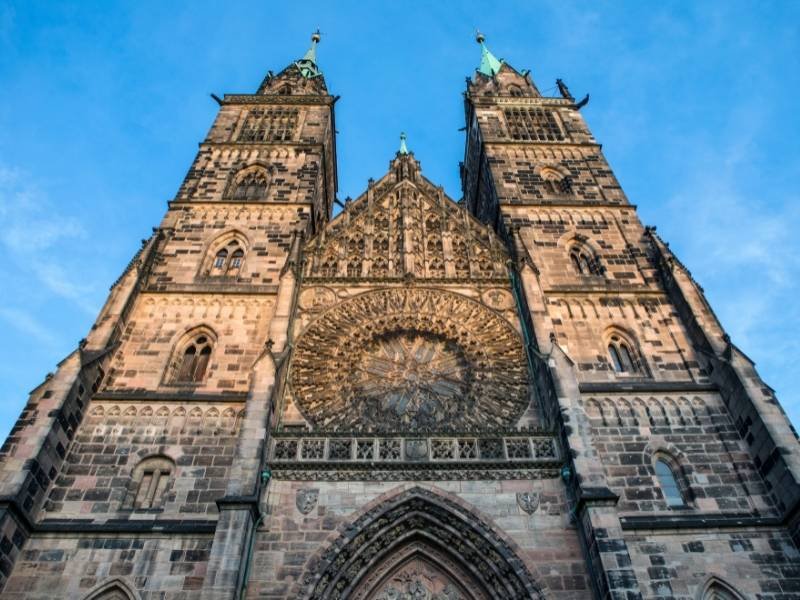
Construction of Lorenzkirche began shortly after that of Sebalduskirche, making it one of Nuremberg’s oldest churches. Like Sebalduskirche, Lorenzkirche is renowned for its beauty. Its imposing west facade will surely captivate you.
The 9-meter-diameter rose window, the tympanum, and the embellishments on the middle spire are nothing short of majestic. It’s no wonder it’s hailed as one of Bavaria’s most beautiful Lutheran churches.
Lorenzkirche is home to several artworks that even survived the Iconoclasm during the Reformation. Each piece, from the stained glass windows to the medieval altars, is strikingly beautiful. Be sure to see Veit Stoss’ early 16th-century artwork, the Angelic Greeting. And don’t miss its three-pipe organ – considered one of the largest in the world with an astounding 12,000 pipes and 165 registers.
360-degree-image of Lorenzkirche above (Swipe to see more views)
You can find Lorenzkirche a few steps south of the Museum Bridge in River Pegnitz. Here is the exact location from Google Maps. Lorenzkirche is open for visitors from 9:00 am until 5:00 pm every Monday to Wednesday, Friday, and Saturday.
Every Thursday, it has the same opening hours but closes at 9:00 pm. The church accepts visitors only from 10:00 am to 3:30 pm on Sundays. Sometimes, concerts occur inside Lorenzkirche. You cannot enter the church during that time. See Nuremberg’s official tourism website for more information.
Admission costs only 1 EUR. But, if you want to tour the tower, you must pay 5 EUR more.
Frauenkirche

For those who appreciate architecture, exploring churches in Nuremberg can be an enjoyable experience. If you’re Catholic, there’s an added incentive to visit. Frauenkirche, one of Nuremberg’s Catholic churches, is another architectural marvel worth seeing.
Although it’s not as grand as Lorenzkirche and Sebalduskirche, its stunning west facade will leave you impressed. The facade showcases a unique German architectural design with embossed decorations on the tympanum beneath the central porch that are sure to captivate you.
The towers attached to the facade and the pinnacles on top are an elegant sight even from a distance. Also noteworthy is the Männleinlaufen, a mechanical clock situated on the upper part of the facade.
Inside Frauenkirche, be sure to check out Nuremberg’s oldest stained-glass windows and various artworks, including a stone sculpture cycle in the choir from 1360 and the Tucher altar, a panel painting created in 1445.
360-degree-image of Frauenkirche above (Swipe to see more views)
Frauenkirche is on the east side of Nuremberg’s main market square (Hauptmarkt). It is only a few steps away from Museum Bridge in the Pegnitz River. If you can’t find it, here’s the exact location of Frauenkirche on Google Maps.
Are you planning to visit Frauenkirche? It is open from 10:00 am to 5:30 pm, Monday to Saturday. On Sunday, it’s 1:00 pm to 5:30 pm. There are no admission fees. But you can donate for generosity.
3. Nuremberg Imperial Castle



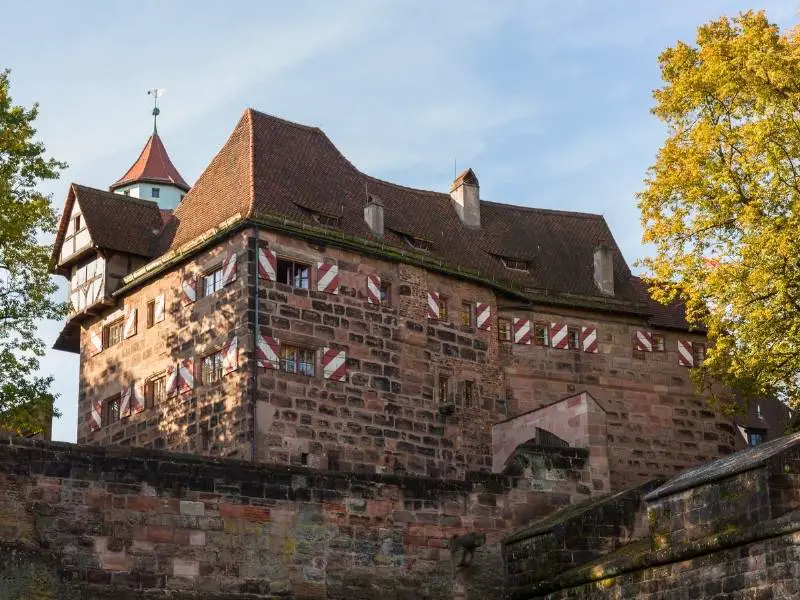
If you’re a history buff like me, you’re going to love Nuremberg in Germany. It’s not just about the medieval look of the city, but also its historical significance.
Did you know that Nuremberg Castle is home to some of Europe’s most impressive medieval fortifications? This castle was once the power hub for the Holy Roman Empire, where kings and emperors used to hang out.
Perched on a sandstone ridge, it offers some seriously stunning views of the city. While it’s no longer a grand military stronghold, it’s still pretty incredible. For instance, its Imperial Stables are now one of Germany’s largest and most modern youth hostels. And guess what? Nuremberg Castle is still the city’s top landmark, visible from miles away.
From west to east:
- Palas
- Imperial Chapel
- Heathens’ Tower
- Sinwell Tower
- Imperial Stables
- Luginsland Tower
By the way, do you like visiting beautiful places like castles and palaces? You should check out Munich. There are three palaces in this city.
As soon as you enter the Imperial Castle of Nuremberg, you’ll see it’s not your average castle. It’s actually a complex full of fortified structures with loads to explore. There’s a stunning garden, a deep well, several chapels, and even a museum within the castle grounds! Even though it was heavily damaged during World War II, the restoration work is seriously impressive.
If you’re up for learning more about the castle and city’s history, you should definitely take a “tour of the Palas.” You’ll get to check out both floors of the Palas and see some amazing sights like the Knights’ Hall, Saint Margaret’s Chapel, Imperial Hall, Emperor’s Chamber, and Bower.
The Bower is where you’ll find the Imperial Castle Museum which has a huge collection of armor, shields, and weapons from medieval times. Discover more about the museum from its official website.
360-degree-image of Nuremberg Imperial Castle above (Swipe to see more views)
Thinking about checking out the Nuremberg Imperial Castle? It’s open from 9:00 am to 6:00 pm from April through October 3. From October 4 through March, they trim the hours back a bit to 10:00 am until 4:00 pm.
Just make sure you arrive at least 45 minutes before they close! You’ll definitely want to see the Castle Gardens while you’re there – it’s the perfect place for sunset or golden hour views!
But remember, it’s only open from April 15 through October, from 8:00 am until nightfall. If you’re bringing the kids, they’ll get in free if they’re under 18. Adults pay an admission fee of 7 EUR, which gets you into Palas, Deep Well, and Sinwell Tower. And bonus – there’s no charge to enter the Castle Gardens.
Learn more from the official website of the Imperial Castle.
4. Unique Fountain in Nuremberg
Nuremberg’s streets aren’t just for snapping photos – there’s a whole world to discover in this medieval town. It’s like wandering through an open-air museum filled with stunning artworks.
And if you’re after something extra special, don’t miss out on the city’s gorgeous fountains. These hidden gems might take a bit of effort to find, but trust me, they’re worth it. Want to know where to find Nuremberg’s most beautiful fountains? Take a look at the list below!
Click the names of the fountains above to see their exact location in Google Maps.
Ehekarussell
Among the three I mentioned, Ehekarussell and Schöner Brunnen are the two you should not miss seeing. Both fountains are beautiful. But, can you guess which fountain depicts a story?
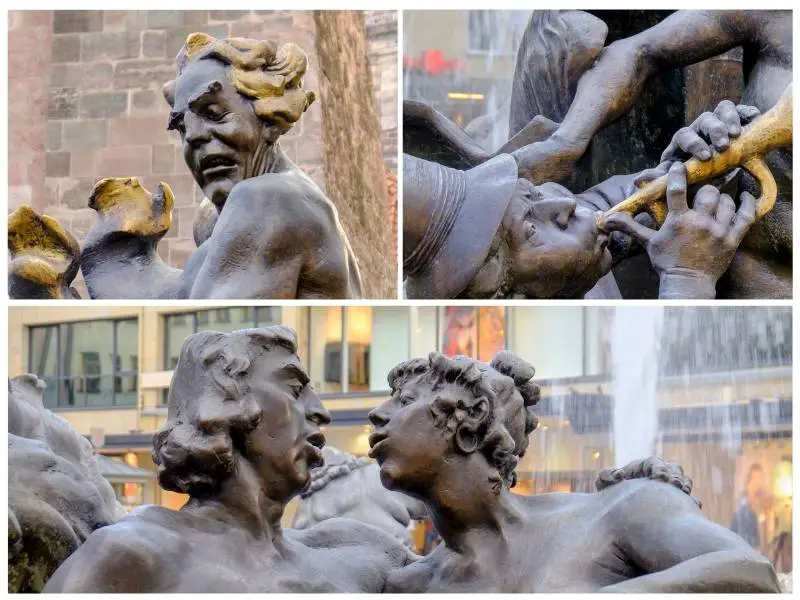
If you think it is Ehekarussell, you are right! You can read its description from Atlas Obscura. But, in short, it’s a fountain with controversial meaning and horrific sculptures. It may not be suitable for all. Ehekarussell depicts the scene in the poem “Bitter-Sweet Married Life” by Hans Sachs.
The sculptures in the fountain include a monstrous lizard, nudes, and the undead. If this still interests you, visit it near Weisser Turm tower (see it on Google Maps).
Schöner Brunnen
Schöner Brunnen is one of the main attractions in Nuremberg. This famous 14th-century fountain resembles a Gothic spire 19 meters tall. You can find it on Hauptmarkt (see exact location in Google Maps).
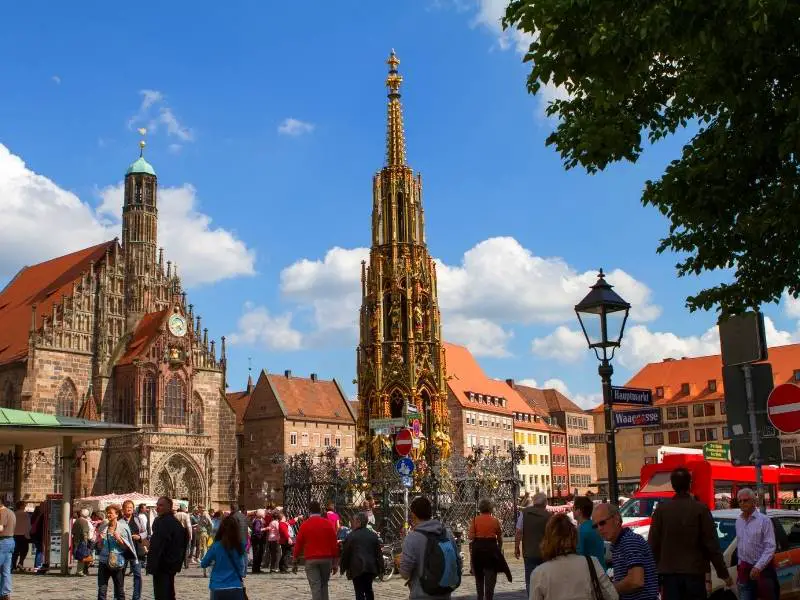


What sets Schonerbunnen apart from other fountains? For one, it boasts an impressive size. However, what really makes it unique are the 40 colorful figures on its spire. These figures depict some of the most important characters from the world of the Holy Roman Empire.
The spire is also adorned with golden embellishments that are sure to catch your attention. Before you leave the fountain, be sure to spin the two brass rings found on the fence. Legend has it that doing so brings good luck to those who give them a spin.
5. Nuremberg’s Instagrammable River and Bridges
Nuremberg, a city bisected by the tranquil River Pegnitz, is unified by its distinctive bridges. These aren’t just ordinary structures; they offer a unique and picturesque panorama of the city. The serene river mirrors the charm of Nuremberg’s homes, creating a breathtaking spectacle.
The blend of nature and quaint medieval architecture makes the city’s bridges a must-visit. Visit during sunset for an incredibly romantic experience, with everything enveloped in a warm, golden hue. Imagine proposing to your loved one in such an enchanting setting – a memory to cherish forever!
While not all bridges offer stunning views, I strongly suggest exploring at least one of the bridges mentioned below.
I arranged the list of bridges above from middle-east to the west across the Pegnitz River. The links above will show the bridges’ exact location in Google Maps.
Kettensteg & Schlayerturm
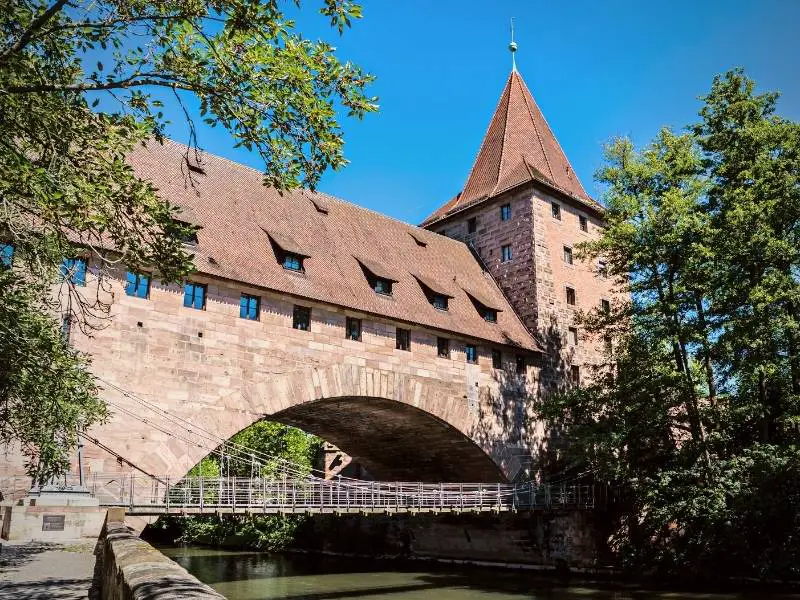
If you ask me, Kettensteg & Schlayerturm are the real deal among the four bridges in Nuremberg. They might not be medieval stone bridges like Museumsbrücke, Fleischbrücke, and Maxbrücke, but they’ve got their own charm.
They’re tucked away from the usual tourist spots, so you can enjoy some peaceful moments, almost like stepping back in time. Fun fact – Schlayerturm is a fortification from the early 15th century and it’s perched on a tiny island in the middle of the Pegnitz River. Its pitched roof and sandstone blocks could easily be a backdrop for a medieval movie!
And right next to it is Kettensteg, the chain bridge. It gives you a fantastic view of Schlayerturm and its stunning architecture.
Plus, they’re beautifully lit up at night.
Maxbrücke

Now, let’s talk about Maxbrücke. It’s over on the eastern side of Kettensteg & Schlayerturm. They’re neighbors, so it’s easy to spot them both. And here’s a tip – if you want the perfect photo of Schlayerturm, head over to Maxbrücke.
As you cross Maxbrücke, there’s more than just Schlayerturm to feast your eyes on. On the opposite bank, you’ll find the Henkerhaus Museum – another slice of medieval history.
Museumsbrücke & Fleischbrücke
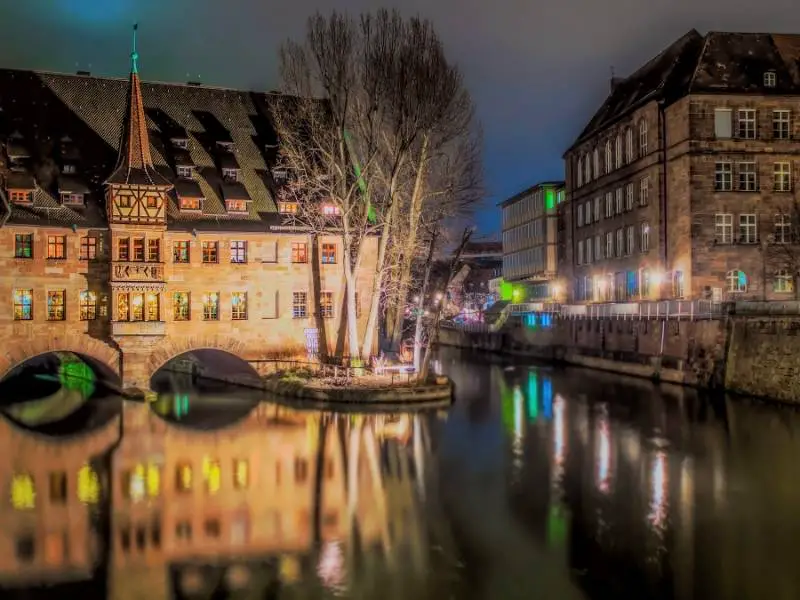
If you’re up for a little time travel, head south of the Hauptmarkt and check out the Museumsbrücke and Fleischbrücke bridges. Now, they might not be a nature lover’s dream, but they’re like a window to Nuremberg’s past.
Fleischbrücke is the older of the two bridges, dating back to the late 16th century, while Museumsbrücke was built as a replacement for the ruined 13th-century bridge. Even though they are just a quick stop, these two bridges offer many photo opportunities, allowing you to catch a glimpse of the two largest islands of the Pegnitz River.
Over on the eastern side of Museumsbrücke, you’ll spot the Heilig-Geist-Spital, another gem with preserved medieval architecture. If the river’s calm, you’ll see its reflection dancing on the water.
See sample Nuremberg Itinerary: Spend 1,2,3 Days in Nuremberg, Germany
6. More Time-Transporting Places in Nuremberg
Nuremberg is bursting with history, and there’s so much more to see beyond the castle, bridges, and churches. There are loads of beautiful and nostalgic places just waiting for you to find them.
How about stepping back in time and exploring hidden gardens, cellars, and medieval dungeons? You absolutely can’t miss the charming islands of the Pegnitz River – they’re a hidden gem that’s worth discovering.
These lesser-known spots add to the charm of Nuremberg and give you even more reasons to visit. If you’re a slow traveler who likes to savor every moment, then these destinations should definitely make your must-see list. You never know what surprises you might find when you venture off the beaten path!
Here is a list summary of the less-visited yet beautiful places in Nuremberg:
I arranged them in no particular order. You may click the links above to see where they are in Google Maps.
Trödelmarkt
Have you heard about Trödelmarkt? It’s this quaint neighborhood in Nuremberg that was actually a pig market in medieval times. It’s got a lovely wooden bridge, some beautifully preserved houses, and lots of little shops that are just too cute.
If you’re on a tight budget – there’s a small park on the eastern tip of the island where you can kick back and soak up the river views. And make sure you check out Henkerbrücke on the other side – it’s a gorgeous wooden bridge that’s Instagram-worthy.
Historic Rock-Cut Cellars
Attention, beer enthusiasts! Nuremberg is the place to be! (It’s Bavaria, need I say more?) In Nuremberg, you can explore an enthralling network of underground cellars brimming with captivating tales just waiting to be discovered. These cellars, known as the Historic Rock-Cut Cellars of Nuremberg, form the most extensive and continuous maze of cellars in all of Southern Germany.
See visiting information from the website of the tourism office of Nuremberg.
Medieval Dungeons
Ready to uncover some hidden secrets of Nuremberg’s past? Head over to the Historic City Hall. You’ll find a collection of 14th-century prison tools that were used for interrogations back in the day. Pretty intense, right? Plus, you’ll get the inside scoop on the old legal system of the Nuremberg Imperial city.
Learn about the visiting information from Nuremberg’s tourism website.
Bürgermeistergarten
Did you know there’s a magical garden near Nuremberg Castle? It’s called Bürgermeistergarten and it’s also straight out of a fairy tale. Wander along its charming cobblestone paths, step through enchanting stone gates, and marvel at the mythical figures that call this place home.
Don’t forget to take in the breathtaking view of Tiergärtnertorplatz and the Albrecht Dürer House! The garden is open from 8:00 am until 8:00 pm. With cozy benches and shady trees, it’s an ideal place to unwind and watch the sunset.
Hesperidengärten
Imagine being transported to the charm of the 17th and 18th centuries through a classic Italian garden. The perfectly pruned bushes and graceful statues are a visual treat. Want to check it out? Grab a drone and get ready to capture the stunning geometric designs of Hesperidengärten from a bird’s eye view.
It’s open from 8:00 am until 8:00 pm, just like Bürgermeistergarten. And guess what? There’s no admission fee!
7. Documentation Center Nazi Party Rallying Grounds
If you find yourself in Nuremberg, be sure to visit the Documentation Center Nazi Party Rallying Grounds. It’s not just a unique attraction, it’s a portal to another intriguing era in the history of Germany!
This museum is located in The Congress Hall, which once echoed with the voices of Nazi gatherings. Just a stone’s throw away from Nuremberg city center – a mere 16-minute train ride – it promises an experience that will etch itself into your memory.
(See the museum’s location from Google Maps)
360-degree-image of Documentation Center Nazi Party Rallying Grounds above (Swipe to see more views)
When you approach Congress Hall, its sheer size is sure to impress you. With its colosseum-like structure, it could host large gatherings during a Nazi rally. But it’s not your typical circular building – it has a distinctive horseshoe shape that’s only visible from above.
The imposing exterior is just a teaser of what lies within – a wealth of intriguing insights into the events, ideology, and architecture of the Nazi regime. Visiting Congress Hall is like stepping into a time machine that takes you to the darker side of German history, revealing how propaganda was used as a tool to manipulate public opinion.
The Documentation Center Nazi Party Rallying Grounds museum is always evolving. It previously featured a permanent exhibition called “Fascination and Terror,” which delved into the causes, context, and aftermath of Nazi Germany.
However, this exhibition has been replaced with “Nuremberg – Site of the Nazi Party Rallies,” a temporary showcase presenting various items related to Nazi and Nuremberg history from 1819 to 1945.
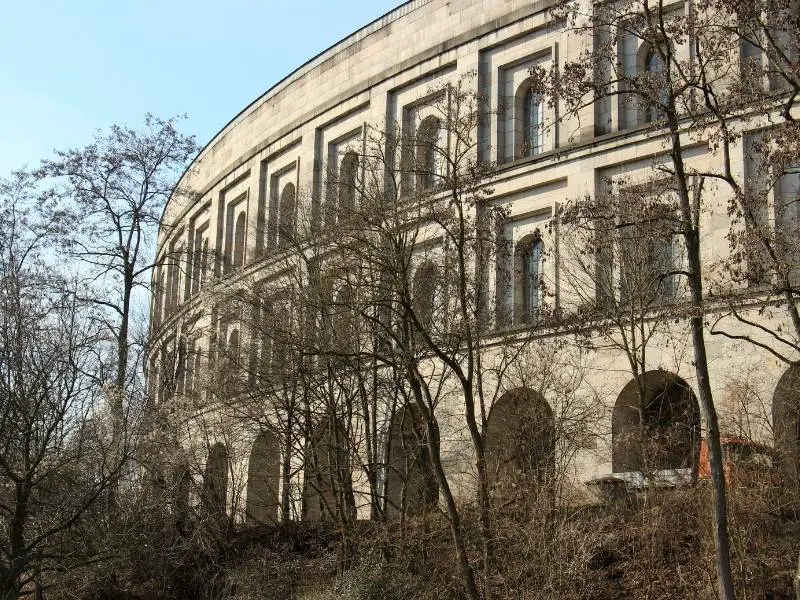
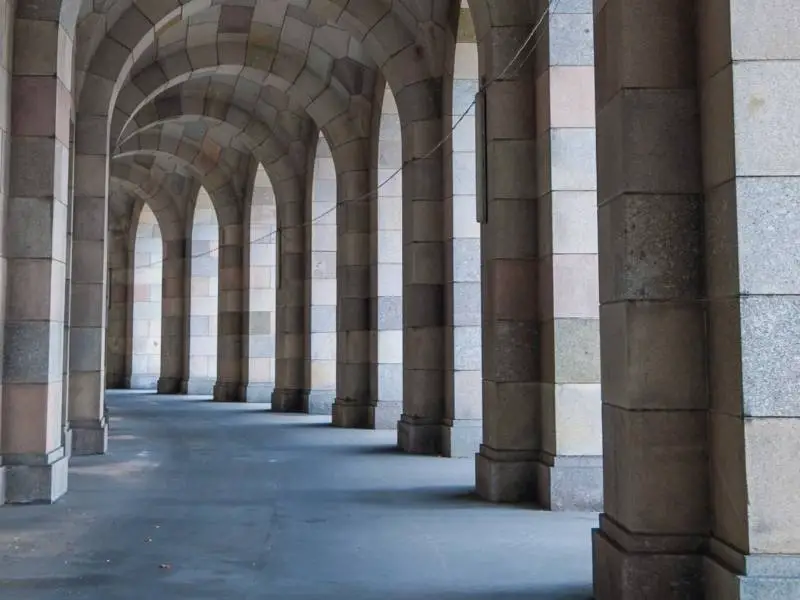

The museum is on continuous improvements. It is why it’s better to visit the museum’s website for the latest updates. You can enter the museum from 10:00 am to 6:00 pm, Monday to Sunday. The admission fee is 6 EUR.
For Instagrammers and photography enthusiasts, try my suggestion. If you want to photograph the Nazi Congress Hall, go to the other side of the lake beside the building. It’s a beautiful spot to capture the hall with an inverted image on the lake’s surface.
8. Fascinating Museums in Nuremberg
Nuremberg is a city that caters to everyone’s interests, whether it’s discovering different cultures or learning about history. The city is home to over 50 museums, covering topics that range from science and technology to arts and culture, and even local history to more unusual subjects.
For those who love museum-hopping, Nuremberg is the perfect destination. In this section, we’ll highlight some of the most fascinating museums in the city – there are too many to cover them all! If you ask me, what are the three museums good enough to be a reason to visit Nuremberg? They are the following:
Note that I chose these museums separate from the ones I mentioned in the previous parts of this post. You can click the names of the museums to see their exact location on Google Maps. Let’s begin the discussion with the museum to awaken the kid within us, the Toy Museum.
Toy Museum
Being a millennial, I was lucky enough to play with “actual toys” during my younger years. Seeing those same toys now always brings a smile to my face. Maybe you’re feeling nostalgic too, or perhaps you’re just a curious explorer on the hunt for interesting finds? Either way, Nuremberg’s Toy Museum should definitely be on your list!
360-degree-image of Nuremberg Toy Museum above (Swipe to see more views)
The Nuremberg Toy Museum isn’t just a trip down memory lane for those of us who grew up with “old-school” toys. If you’re on the road with little ones, this museum is a must-visit! They’ll be over the moon with the countless toys on display. You could easily while away half a day exploring every corner of this toy wonderland.
Some of the toys even date back over 600 years – so it’s not just the kids who might spot something familiar!
The museum is open from 10:00 am to 5:00 pm from Tuesday to Friday, and stays open an hour later on weekends and holidays. And the best part? Admission is just 6 EUR for adults and 1.5 EUR for those eligible for discounts.
See more information about the Toy Museum on their official website.
Germanisches Nationalmuseum
Germany, while having a somber side to its history, boasts a culture that I find incredibly amazing. From its stunning architecture to its mesmerizing art – especially the breathtaking German Rococo frescoes! If your heart beats for the same, the Germanisches Nationalmuseum is a must-visit. It might just become one of your “best reasons” to visit Nuremberg.
The museum showcases countless exquisite works crafted by the German-speaking community.
I am not sure if all exhibits in Germanisches Nationalmuseum are on their website. But I’m sure the catalogs will give you a glimpse of what items await you in the museum. Check it out to feel more excited to come to Nuremberg!
The items found in Germanisches Nationalmuseum in Nuremberg came from all ages of the German culture. There are renaissance and medieval artworks, German weapons, folk culture stuff, clothes, and more! Different visitors spent 2 hours to an entire inside the museum.
Germanisches Nationalmuseum is open from 10:00 am until 6:00 pm from Tuesday to Sunday. On Wednesdays, closing time happens much later, 8:30 pm. Entry is 8 EUR for adults (5 EUR, reduced). See all details from the museum’s official website.
Nuremberg Transport Museum
Believe it or not, Germany is among the countries in Europe with the best railway system.
Do you wonder how? The Nuremberg Transport Museum is the place to go. It’s yet another reason why a visit to Nuremberg is a must, particularly if you’re a fan of all things transport! The museum is home to an impressive range of exhibits, including everything from vintage locomotives to cutting-edge bullet trains.
Fun fact – Nuremberg’s Transport Museum is among the oldest technical history museums in Europe! Plus, it’s the designated museum of Germany’s National Railway Company. Your visit is sure to be packed with fascinating insights and discoveries. Just a heads up though, not all displays and exhibit descriptions are in English.
For a thorough and insightful tour, consider getting an audio guide. They’re available for a nominal fee of 1 EUR. Nuremberg’s Transport Museum has six permanent exhibitions:
- The history of the railway in Germany. (Discover the developments of the German railways from 1835 to the present)
- Bahnhofszeiten. (See how train stations evolved throughout the years)
- Time-traveling with Grandpa Adler. (An interactive museum where stories of the locomotive that ran Germany’s first passenger train service unfold)
- Modellarium (An exhibition with 2,000 models of all different sizes of trains worldwide)
- Outdoor display area (See real nostalgic trains on an open-air site)
- Model railway display (Experience rail operations in miniature)
Bonus! The Transport Museum of Nuremberg includes a communications museum. Play and discover tools used in communications like analog phones, etc.
Do you want to visit? Nuremberg Transport Museum is open from 9:00 am to 5:00 pm from Tuesday to Friday. Every Saturday, Sunday, and holiday, the museum closes an hour later at 6:00 pm. The Entry fee is 7 EUR for adults and 4 EUR for kids. See more visiting information from the museum’s official website. Or, you may download the museum’s app (Appstore, Playstore) for their other services.
9. Nuremberg’s Famous Christmas Market
Aside from scenic views, culture is another reason I want to visit a specific destination. One of the most exciting things about a place is how its culture makes it unique, especially when it involves human interaction.
It’s amazing to see how people keep their heritage alive. Cultures take years to develop and maintain, and discovering one that’s been around for centuries is a real privilege. Often, it is more than a discovery, but an amusing moment that makes a beautiful memory.

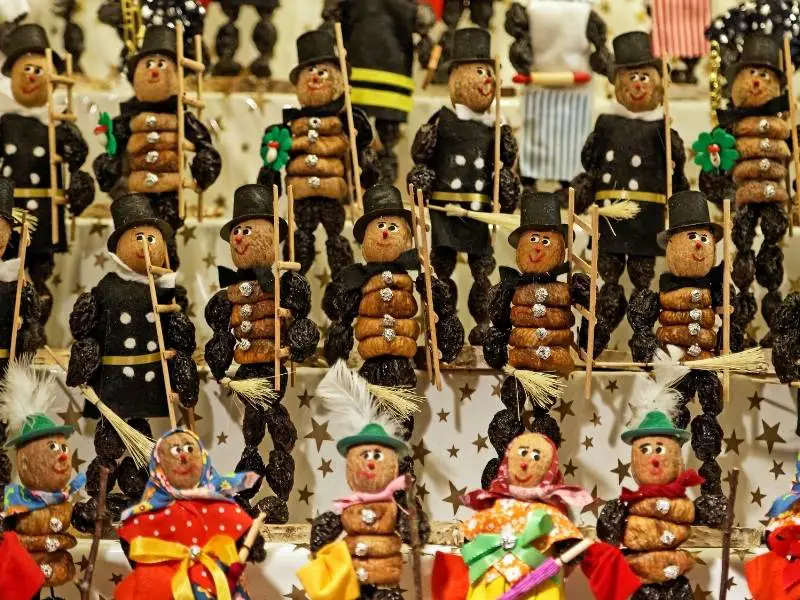
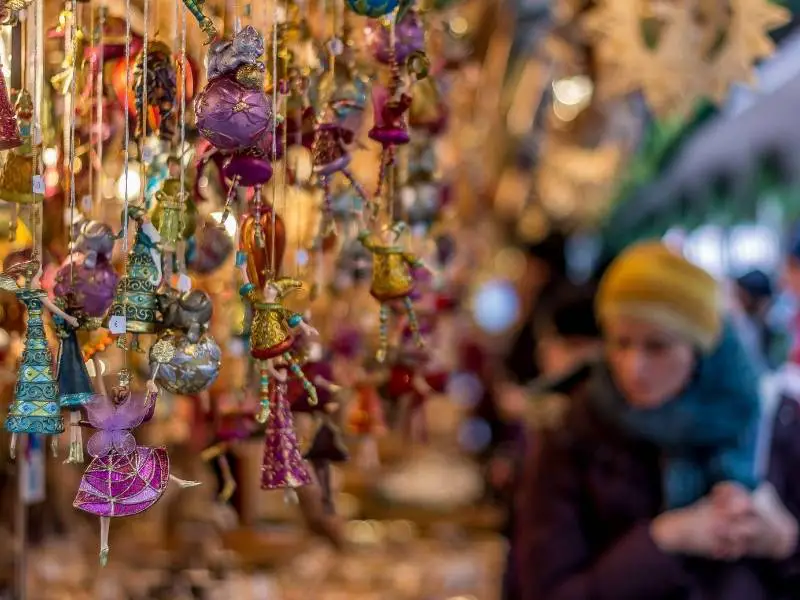
Every December, Nuremberg transforms into a magical wonderland that beautifully showcases German culture. If you’re thinking it’s because of the Christmas Markets, you’re spot on!
While you can find Christmas markets across the globe, the most authentic ones are nestled in German cities like Nuremberg. In fact, Nuremberg is the birthplace of Christmas markets, with a tradition dating back over 700 years.
Typically set up in the town square, these markets feature open-air stalls selling traditional and seasonal items, alongside food stands offering classic German delicacies like Nuremberger sausages (Wurst), potato pancakes (Kartoffelpuffer), roasted almonds (Gebrannte Mandeln), mouth-watering crepes, warm waffles, and the famous gingerbread.
The dazzling lights and sparkling decorations add to the enchantment of the markets! It’s a family affair with mini carnivals for the kids to enjoy. Plus, you can catch Christmas performances like carol singing and Mozart Christmas songs in the town courtyards and churches. And let’s not forget Christkind, the symbol of Nuremberg’s Christmas Market, who makes the experience unforgettable.
Learn everything about Nuremberg Christmas Market from its official website.
The Christmas market in Nuremberg starts around the last week of November or the first week of December. The last day is on December 24. It is open from 10:00 am until 9:00 pm from Monday to Sunday. On December 24, the Christmas market closes earlier, at 2:00 pm.
See sample Nuremberg Itinerary: Spend 1,2,3 Days in Nuremberg, Germany
10. More Fun Events in Nuremberg
While the Nuremberg Christmas market is a major draw, the city also hosts a plethora of other events that are well worth your time. From vibrant cultural festivals to captivating art exhibits, Nuremberg offers a diverse array of experiences to cater to varied interests all year round.
Nuremberg Festivals
Nuremberg is a city that knows how to have a good time, and its three festivals are a testament to that! Beer, film, and music festivals are celebrated here, showcasing the lively and modern German culture that resonates with everyone.
The Fränkisches Bierfest (Franconian Beer Festival) is a standout event, taking place in the moat of Nuremberg Castle. This festival draws in both locals and tourists alike, and is often hailed as the “largest” beer garden festival in the world! It’s an experience not to be missed.
For a truly memorable experience, make your way to Nuremberg’s mid-June festivals! With over 40 local breweries serving up more than 100 varieties of beer, and local artists keeping the atmosphere lively with their dynamic performances, it’s a celebration you won’t want to miss.
The festival also offers a wide array of culinary delights to tantalize your taste buds. Solo travelers will find this event a great opportunity to mingle and make new friends, while those interested in culture can indulge in Nuremberg’s markets – it’s a mini-paradise indeed.
Nuremberg Markets
Nuremberg has a Christmas Market, Easter Market, Autumn Market, and more flea markets.
Collectors will be spoilt for choice at the markets in Nuremberg! With a vast array of items on offer, from handmade baskets to hand-blown art glasses, table decorations, ceramic figures, and more, there’s something for everyone.
If you’re planning a visit to one of Nuremberg’s markets, I’d highly recommend the Autumn Market. This lively market coincides with the Old Town Festival, turning Nuremberg into a vibrant hub brimming with free activities for all to enjoy.
During the Autumn Market and Old Town Festival, you’ll get the chance to delve into local crafts and enjoy a diverse entertainment program. The whole city comes alive to celebrate regional cuisine and local traditions, offering a fantastic opportunity to immerse yourself in Franconian culture.
11. Nuremberg Zoo for Kids
If you’ve been keeping up, you’ll know that Nuremberg is a city brimming with activities and attractions. Whether it’s diving into its rich history or marveling at its stunning architecture, there’s always something to captivate you.
However, there’s more! Nuremberg also boasts one of the largest zoos in Europe. So, whether you’re traveling with your family or you’re an animal lover, a visit to the zoo is a fantastic way to complete your Nuremberg adventure.
Did you know that Nuremberg Zoo is a sanctuary for about 3000 animals spanning 300 species, all housed in natural enclosures designed to replicate their native habitats? This isn’t your typical zoo – Nuremberg Zoo offers a guilt-free experience for visitors.
It’s also home to a variety of exotic wildlife that you might not see elsewhere, including Siberian tigers, snow leopards, and polar bears. You’ll even encounter some lesser-known species like Indian rhinoceroses, Malayan tapirs, and Turkmenian kulans. If you’re keen to see all the animals, plan to spend half or even a whole day at the zoo.
Getting there is easy – just hop on the #E5 bus from Nuremberg train station, and you’ll be there in about 30 minutes. Nuremberg Zoo is open from 8:00 am to 7:30 pm. But you have to come at least mid-afternoon to fully enjoy the zoo. I urge you to read the visiting information and announcements before coming to the zoo.
The admission fee for adults is 18 EUR. For teens and kids, it is 13.5 EUR and 8.5 EUR. You can buy package tickets to save some EUR. Learn more from the Admission Fee page of Nuremberg Zoo.
12. Nuremberg’s Culinary Delights
Nuremberg is a sensory delight, also for the taste buds. The city’s unique culinary journey is sure to captivate food enthusiasts. If you’re a gastronome with a penchant for savouring delectable dishes during your travels, Nuremberg is also your destination.
The city’s two signature dishes – the Nuremberg Sausage (Bratwurst) and gingerbread (Lebkuchen) – are not to be missed. They are particularly delightful during the festive season at the Nuremberg Christmas Markets.

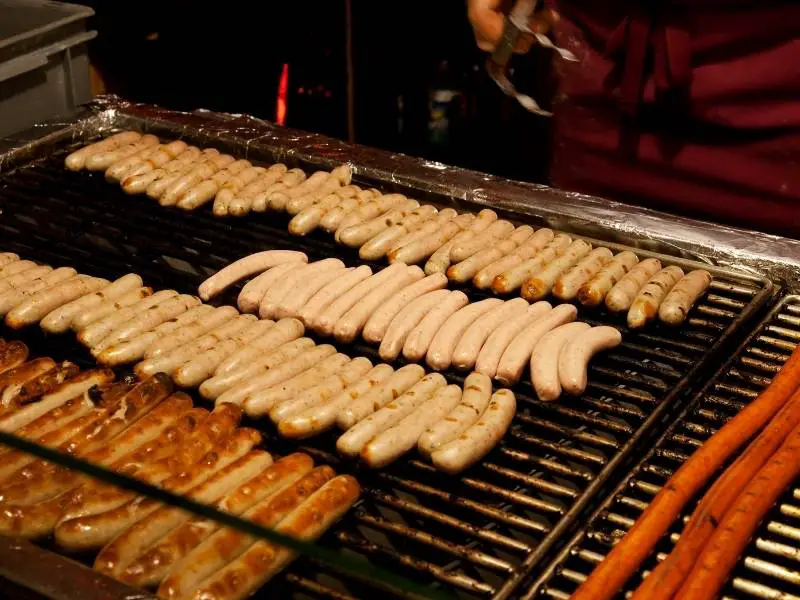
Bratwurst – what makes it so special? This traditional sausage has been a staple in Nuremberg kitchens for over 700 years! Believe it or not, the recipe has remained unchanged since the City Council made it law back in 1313.
To this day, locals still take great pride in producing over 3 million small sausages annually, with the help of the European Union Product of Protected Geographical Indication (PGI) to ensure consistent quality.
Not to be outdone, Nuremberg also boasts another famous specialty – Lebkuchen, or gingerbread. This sweet treat has a history dating back to the 14th century, when it was first made by Franconian Monks. Today, it is a registered “protected geographical indication” and must contain at least 25% nuts and no more than 10% flour.
13. Nuremberg’s Leisure Activities
Another enticing aspect of Nuremberg is the abundance of water bodies within and around the city. These natural features make Nuremberg an ideal destination for those seeking a blend of urban exploration and outdoor adventures.
This unique combination sets Nuremberg apart from other cities and is a significant attraction for visitors. While these natural gems might not be immediately visible on a standard map, a closer look reveals two lakes nestled to the east of the city, waiting to be discovered.

For locals, the Wöhrder See is the go-to spot when they’re looking for a nearby recreational area. And for travelers like us, it’s the perfect place to relax after exploring Nuremberg. While the lake doesn’t offer many activities, it’s a great spot for sightseeing.
You’ll find several hiking trails, picnic areas, and restaurants nearby that offer breathtaking views of the Nuremberg skyline. The Wöhrder See is also home to a few artworks, including one on the beach and another near the Pegnitz River, making it a place full of little surprises.
There’s another lake you can visit located next to the Congress Hall, which was built by the Nazis. It’s called Dutzendteich Lake and it’s a wonderful place to engage in leisure activities. You can enjoy a stroll, cycle around the lake, rent a pedal boat, or even go sailing! Dutzendteich Lake is particularly picturesque during sunset.
Consider bringing your camera during the golden hour to take stunning photos of the lake. If the water is still, you might even see the Congress Hall’s reflection on the surface.
14. Exciting Day Trips From Nuremberg
Nuremberg serves as an ideal gateway to the wider region of Franconia. Its strategic location makes it a savvy choice for explorers. Although not an official capital, Nuremberg acts as a nexus for numerous tourist hotspots.
From here, you can embark on a variety of day trips to visit the breathtaking, history-rich towns in the vicinity, renowned for their well-preserved medieval architecture.
Bamberg
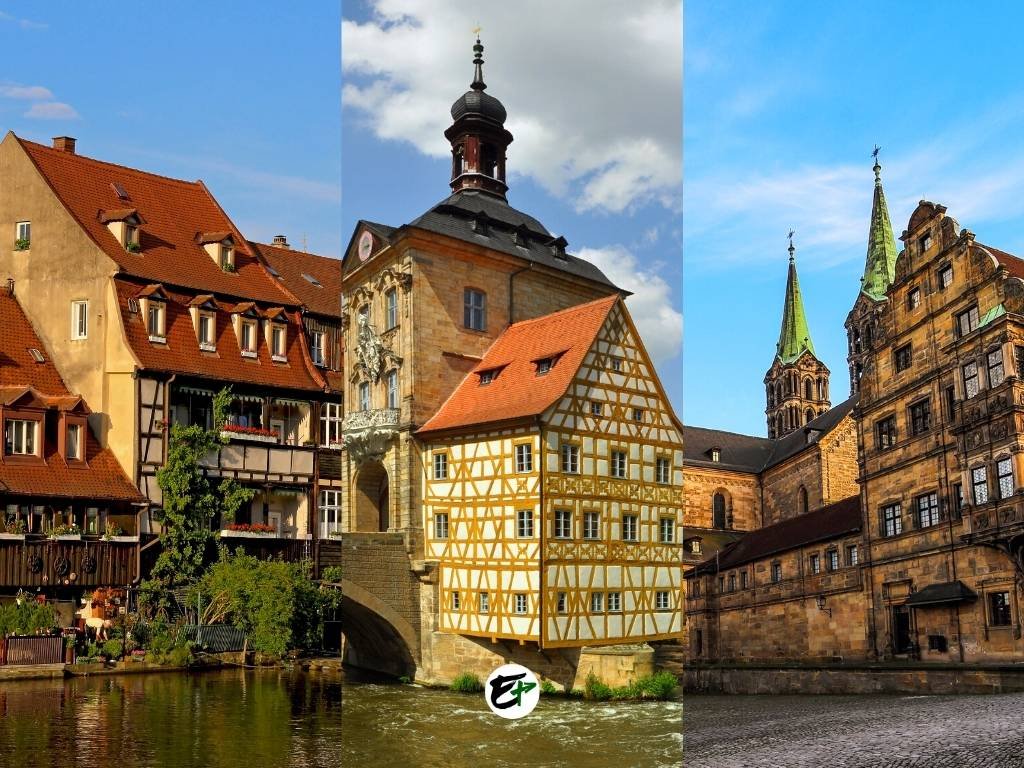
Bamberg is the first on the list, and it’s a charming town that draws comparisons to Rome and Venice. Similar to Rome, Bamberg boasts seven hills and churches atop them. Additionally, like Venice, visitors can take a gondola ride on the River Regnitz and pass through its historic town.
You can’t leave Bamberg without trying its centuries-old smoked beer tradition, which is one of the town’s unique features. And don’t miss the opportunity to see its primary landmark, the town hall.
Wurzburg
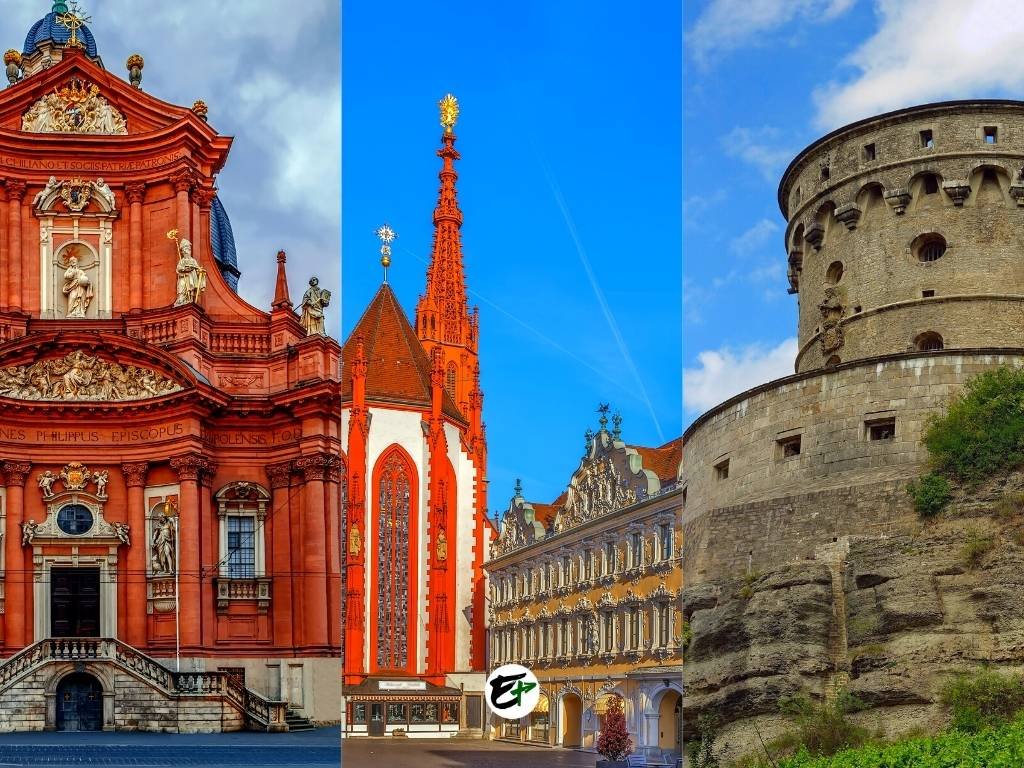
Wurzburg is a great town to visit from Nuremberg – it’s larger than Bamberg and is famous for its dry wines. Known also as the ‘city of 100 churches’, Wurzburg boasts some of the most beautiful Rococo architecture you’ll ever see. And if you’re a fan of stunning buildings, churches, and palaces, you won’t want to miss out on visiting Wurzburg Residence.
Rothenburg ob der Tauber
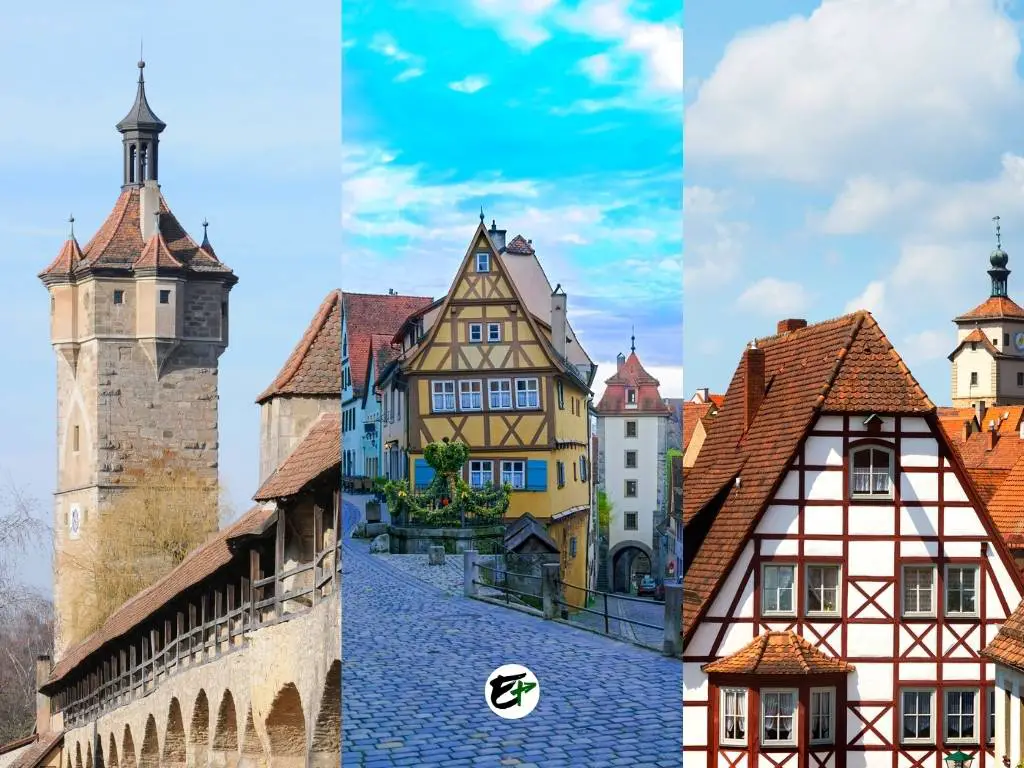
Ever fancied a trip back to the medieval era? Rothenburg ob der Tauber in Germany offers you just that. It’s not merely a “magical” experience, but a voyage that whisks you away to a different realm. Rothenburg, with its enchanting allure, is one of Germany’s most frequented and picturesque towns. It’s also one of the rare three villages in the country that still retain their medieval walls intact.
15. Lovely Souvenirs from Nuremberg Craftmen’s Courtyard
A top draw for visitors to Nuremberg is the Craftsmen Courtyard, another attraction that should not be missed. This is the place to find handcrafted souvenirs that will serve as enduring mementos of your Nuremberg adventure.
The array of items on offer is truly impressive, with a plethora of delightful pieces to choose from! Take your time to explore the selection, and you’re bound to discover a keepsake that you’ll cherish for a lifetime.
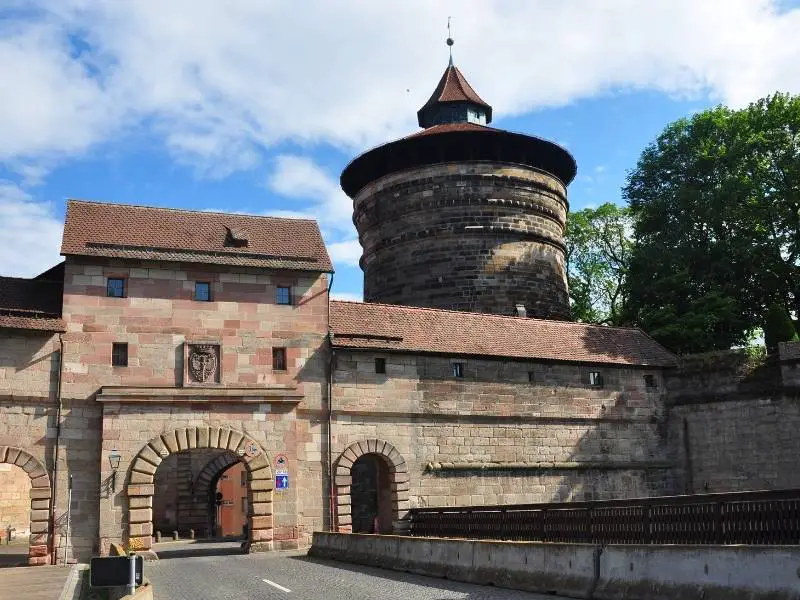
The Craftsmen’s Courtyard is a paradise for lovers of handmade crafts, offering a variety of items from wooden toys to sparkling jewelry and home accessories. These pieces are bound to fuel your wanderlust and add a dash of enchantment to your space.
The quaint charm of this place is tangible, from the colorful adornments to the cobblestone streets and half-timbered houses. Situated next to Nuremberg’s wall, the scenes from the Craftsmen’s Courtyard are nothing short of breathtaking, with its towering structures and brick walls exuding an old-world charm.
The cobblestone streets are dotted with delightful shops and cozy cafes that offer the best of Franconian and Nuremberg delicacies. Enjoy a delectable meal of Bratwurst and genuine gingerbreads while appreciating the stunning views in the vicinity.
360-degree-image of Handwerkerhof Nuremberg above (Swipe to see more views)
See Nuremberg Craftsmen’s Courtyard or Handwerkerhof Nürnberg’s location from this link to Google Maps. If you plan to visit, I suggest checking the announcements on its official website before going. The website is in German, though.
Handwerkerhof Nürnberg is open daily from 8:00 am to 10:30 pm from Monday to Saturday. Every Sunday, it opens a little bit later, at 10:00 am. There’s no entry fee, so don’t miss it!
Continue Reading: Nuremberg Itinerary: Spend 1,2,3 Days in Nuremberg, Germany.
If you’re interested in discovering the beauty of Southern Germany, it’s worth noting that Nuremberg isn’t the only city that should be on your radar. Personally, I find Munich and Stuttgart to be nice destinations, too, and I suggest you consider visiting both of them during your trip planning Like Nuremberg, Stuttgart and Munich have easy access to the most beautiful places in Southern Germany
- From Stuttgart, you can quickly reach Lichtenstein Castle and the Black Forest.
- From Munich, visiting Garmisch-Partenkirchen, Berchtesgaden, Mittenwald, Neuschwanstein Castle, and Oberammergau is simple. These are the towns in the Bavarian Alps, and here’s how you can explore the Bavarian Alps in 3, 7, or 10 days.
Save it on Pinterest.




